In the world of music production, gigging, and content creation, the microphone is a crucial piece of kit. A good mic will capture all the nuances of a performance or voiceover in exquisite detail, but high-quality sound doesn’t always mean high cost!
Whether you’re a musician, producer, or content creator, we’re here with our top picks of the best microphones under £100 to help you find the right mic for you without breaking the bank.
In a hurry?
If you’re in a rush, here are our top three microphones for under £100:
| Shure SM48 Dynamic Microphone | Legendary vocal microphone with a sought-after tone. | Check the current price |
| Rode Podmic Dynamic Podcasting Microphone | A fantastic podcasting microphone with a tight cardioid polar pattern for exceptionally clear vocals. | Check the current price |
| G4M Pencil Condenser Microphone with Capsule Set | A great all-around microphone, complete with three interchangeable capsules. | Check the current price |
The best microphones under £100
1. Shure SM48 Dynamic Vocal Microphone
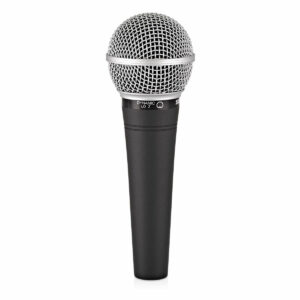 Key features
Key features
- Tailored frequency response of 55Hz – 14kHz
- Cardioid polar pattern
- Comes with a microphone stand clip and carry case
Pros
- Exceptional sound quality
- Effectively reduces background noise
- Accurate vocal reproduction
Cons
- No onboard switch for turning the mic on/off
The Shure SM48 Dynamic Microphone is a workhorse, delivering a professional-grade performance that belies its budget-friendly price tag. It’s designed with a cardioid polar pattern, meaning it minimises feedback and cuts through ambient noise. The result? A clear, focused sound that makes your vocals stand out in any mix.
One of the unique aspects of the Shure SM48 is its brightened midrange and bass roll-off. This allows for precise vocal capture, ensuring every nuance of your voice is picked up. Whether you’re belting out high notes or delivering a subtle spoken word performance, this microphone delivers.
But it’s not just about the technicalities. The sound quality delivered by the Shure SM48 is truly exceptional. It offers a clean, detailed audio profile that’s perfect for both singing and spoken word performances. Plus, its effective noise reduction ensures that your voice is always front and centre, free from distracting background noise.
If you’re after a microphone that offers professional performance, effective noise reduction, and accurate vocal reproduction without breaking the bank, the Shure SM48 Dynamic Microphone is a top contender. It’s proof that you don’t need to spend a fortune to sound like a pro.
2. Shure PGA57 Cardioid Dynamic Instrument Microphone with XLR Cable
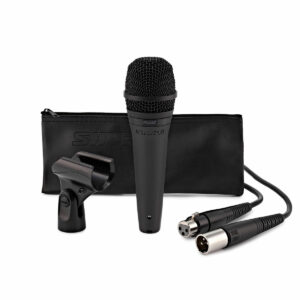 Key features
Key features
- Tailored frequency response of 70Hz – 15kHz
- Presence boost at 6kHz
- Included XLR cable, mic clip, and storage pouch
Pros
- Incredible build quality
- Excels in off-axis noise rejection
- Accurate sound reproduction with a smooth frequency response
Cons
- No built-in shock mount for handling noise
The Shure PGA57 Cardioid Dynamic Instrument Microphone with XLR Cable boasts a cardioid polar pattern, ensuring focused sound capture while minimising background noise. This makes it a fantastic tool for recording various instruments, such as guitar amps, drums, and brass.
As a dynamic microphone, it capably handles high sound pressure levels without distortion. This feature allows it to capture loud and powerful sounds with ease. Plus, with an included XLR cable, connecting to audio interfaces, mixers, and other equipment is a breeze.
As with any Shure product, the PGA57 showcases exceptional construction. It’s built to last, making it a reliable choice for both recording and live performances. It also showcases excellent off-axis rejection, reducing background noise for a clear, focused sound.
A real strength of the PGA57 is its smooth tailored frequency response of 70Hz – 15kHz, providing accurate and natural sound reproduction whatever your sound source – there’s no need to EQ! This makes it versatile enough for a wide range of applications, from home studios to professional recording environments.
Better still, there’s a presence boost at 6kHz, giving some extra punch and bite to your recordings. while a frequency roll at 200Hz softly eliminates any boominess you might experience in home studios or on small stages.
3. G4M Pencil Condenser Microphone with Capsule Set
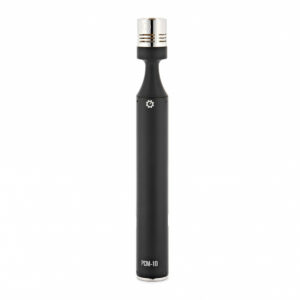 Key features
Key features
- Three interchangeable capsules
- 20Hz-20kHz frequency response
- Comes with a wind sock, plastic carry case, and suspension mount
Pros
- High-quality, professional-grade sound reproduction
- Capability to adapt to various recording situations
- Comes with three capsules to choose from
Cons
- Capsules have to be changed manually
The G4M Pencil Condenser Microphone with Capsule Set is a gem for your home studio, complete with interchangeable capsules: cardioid, hyper-cardioid, and omnidirectional. Whether you’re capturing vocals or instruments, this microphone can adapt to suit your needs.
The compact design is also a real winner here. It allows for precise positioning, so you’ll capture exactly the sound you’re after without any compromise.
With a frequency response ranging from 20Hz to 20kHz, this microphone covers the whole spectrum. Picking up every detail, it provides a high-quality sound reproduction that’s perfect for professional use, whether you’re in the studio or on stage.
4. Lewitt LCT 240 Pro Large-Diaphragm Condenser Microphone
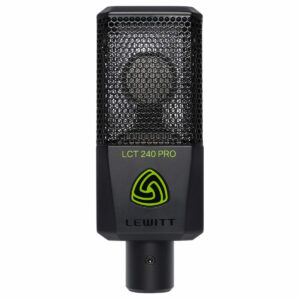 Key features
Key features
- Cardioid polar pattern
- Maximum SPL of 142 dB
- Includes windscreen, microphone clip, and leatherette bag
Pros
- Handles louder instruments without distortion
- Great audio fidelity courtesy of cardioid pattern and extended frequency range
- Ideal for podcasting, live streaming, and gaming
Cons
- Doesn’t include a pop filter which is desirable for studio recording
The Lewitt LCT 240 PRO Large-Diaphragm Condenser Microphone provides an extended frequency range, making it great at capturing every nuance of sound, whilst a cardioid polar pattern rejects off-axis sounds. It’s great for users who want a clean, focused recording, no matter the application or scenario.
With a gold-plated XLR connector, the mic retains signal integrity. And you can use the mic on pretty much any sound source, even extremely loud instruments like drums – the high SPL rating means it won’t distort. Better still, the mic comes with a windscreen to block any plosives or breath noises, a microphone clip, and a leatherette bag.
As well as being suitable for instruments and vocals, the Lewit LCT 240 PRO is ideal for podcasting, live streaming, and gaming. It’s a versatile piece of kit, and with its extensive array of features, it offers excellent value for money.
5. Rode Podmic Dynamic Podcasting Microphone
 Key features
Key features
- Broadcast-quality dynamic capsule
- Tailored frequency response for speech
- Built-in pop filter
Pros
- Crystal-clear sound quality
- Effective noise rejection
- Durable all-metal construction
Cons
- No built-in headphone output
The Rode Podmic is both affordable and of professional quality. It’s built with a dynamic capsule, optimised specifically for speech, ensuring your voice comes through clearly and with depth. This makes it ideal for podcasting, streaming, and voice-over work.
The Podmic also offers excellent noise rejection thanks to its cardioid polar pattern, focusing on your voice while eliminating unwanted background sounds. It’s perfect for recording at home or in environments where there’s a lot of background noise – your voice will ring out loud and clear. The built-in pop filter then reduces plosives and delivers a smooth, clean sound that’s reminiscent of classic radio broadcasts.
Constructed with a robust all-metal body and a stainless steel mesh grille, this microphone is as durable as it is sleek. Whether you’re just starting out or you’re a seasoned podcaster, the Rode PodMic offers a blend of quality and affordability, making it one of the best microphones under £100.
6. Shure CVL-B/C-TQ Miniature Cardioid Condenser Mic for Presenters
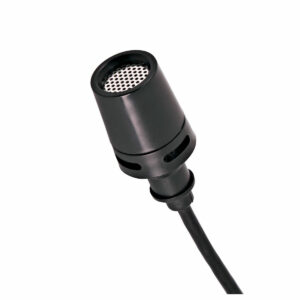 Key features
Key features
- Compact and discrete
- Frequency response of 50Hz – 20kHz – perfect for public speaking
- TA4F (TQG) connector for Shure bodypacks
Pros
- Delivers high-quality, crystal-clear vocal reproduction
- Easily and discretely clips onto clothing
- Included windscreen reduces plosives, wind, and breath noise
Cons
- 1.3-metre cable may not be long enough for some users
The Shure CVL-B/C-TQG Miniature Cardioid Condenser Mic for Presenters is designed to be almost impossible to see when worn, making it a great pick for presenters who want to keep the audience’s focus on their words, not their gear.
The CVL-B/C-TQG is a testament to Shure’s legendary precision engineering, promising maximum durability even in demanding conditions. Though small, the microphone ensures consistent performance over time.
Thanks to a TA4F (TQG) connector, this mic is compatible with any Shure bodypack, making setup quick and easy.
The Shure Miniature Cardioid Condenser is ideal for presentations and public speaking. It delivers high-quality sound with crystal-clear vocal reproduction, ensuring every word is heard with clarity and precision. Plus, it comes complete with a handy tie clip and windscreen for added convenience.
7. Behringer C-3 Condenser Microphone
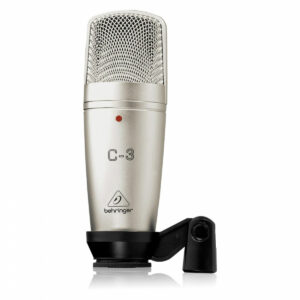 Key features
Key features
- Dual-diaphragm condenser element
- Flexible sound-capturing options with three selectable polar patterns
- Frequency response of 40Hz – 18kHz
Pros
- Precise audio reproduction delivers excellent sound quality
- Three selectable polar patterns let you tailor the response to different sound sources
- Swivel stand mount and transport case included
Cons
- Rear-ended switch for patterns – not as accessible as other mics
If you want something exceptionally flexible, consider the Behringer C-3 Condenser Microphone. It’s an affordable studio mic designed for capturing both vocal and instrument recordings. Boasting a dual-diaphragm design, the mic ensures accurate audio capturing, perfect for picking up all the intricate details of your sound.
In addition, it offers flexible sound-capturing options with its three selectable polar patterns. Whether you’re recording vocals, instruments or ambient sounds, you can select the pattern that best suits your needs. The Behringer C-3 is also built to last. Its rugged construction can withstand the rigours of studio use and transportation.
What’s more, it comes with a swivel stand mount and a transport case, so you can set up immediately.
8. sE Electronics X1 A Condenser Microphone
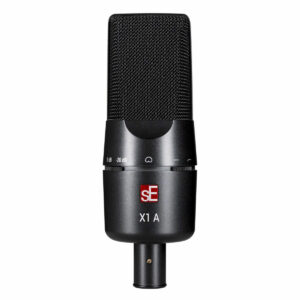 Key features
Key features
- Cardioid polar pattern
- All-metal chassis and integrated windscreen
- Built-in attenuation pad and low-cut switch
Pros
- -20dB pad switch gives you an extended dynamic range
- High-quality build ensures long-lasting performance
- Suitability for a wide range of recording applications
Cons
- Doesn’t include a pop filter like some other mics on this list
The sE Electronics X1 A Condenser Microphone is a versatile and high-quality piece of kit that promises exceptional sound reproduction. This microphone features a cardioid polar pattern, focuses the sound capture and reduces any unwanted background noise. This makes it particularly well-suited for capturing vocals and instruments in both studio and live settings.
Durability is not an issue with the X1 A. Its all-metal chassis, coupled with an integrated windscreen, ensures a robust build that can stand up to regular use while also protecting against plosive sounds.
With a built-in attenuation pad and low-cut switch, you have precise control over the microphone’s sensitivity and frequency response, providing versatility for a wide array of recording applications.
The sound reproduction of the X1 A is clear and detailed, capturing every nuance of the audio source. This, combined with its excellent build quality and versatile recording options, makes it suitable for a variety of recording applications.
9. Sennheiser e835S Cardioid Vocal Mic with Switch
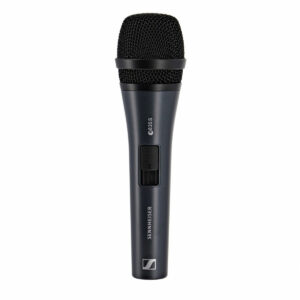 Key features
Key features
- Cardioid polar pattern
- Robust metal enclosure
- Enhanced mid-presence
Pros
- Durable construction guarantees long-lasting use
- Effective in reducing unwanted noise and feedback
- Plug-and-play functionality ensures ease of use
Cons
- Can be used for studio work but other mics may be more suitable for recording vocals
For a convenient plug-and-play mic, the Sennheiser e835S delivers exceptional detail and punchy mids without any unwanted noise or feedback. A dynamic mic with a cardioid polar pattern, it offers enhanced feedback rejection, making it perfect for situations where clear, focused audio capture is paramount.
One of the most handy features of this microphone is its dedicated on/off switch. It allows you to easily manage your recording sessions. Plus, the mic offers enhanced mid-presence. This ensures that your vocals come through loud and clear, making it an excellent choice for singers and public speakers alike.
With a robust metal enclosure, the mic promises longevity and can handle regular use. Plus, with its plug-and-play functionality, it’s incredibly easy to use.
10. SubZero SZM-11 Beta Dynamic Vocal Microphone
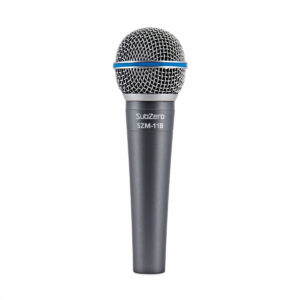 Key features
Key features
- Cardioid polar pattern
- Subtle low-end roll-off at 50Hz
- Detailed frequency response of 50Hz – 16Hz
Pros
- Excellent off-axis noise rejection
- Captures even the softest vocals with clarity
- Suitable for both professional singers and beginners
Cons
- Lacks an onboard switch for turning mic on/off
The SubZero SZM-11 Beta Dynamic Vocal Microphone offers a blend of quality, durability, and versatility. Its cardioid polar pattern ensures a tight and focused sound capture, minimising unwanted background noise and making it perfect for live performances or studio recordings.
With high sensitivity and output, even the subtlest nuances of the voice can be captured, making it an excellent choice for any vocalist, from those just starting out to seasoned professionals. This is aided by the detailed frequency response of 50Hz to 16Hz.
Despite its high-performance capabilities, the SubZero SZM-11 is remarkably easy to handle and transport. Its compact and lightweight design, coupled with a microphone clip for easy mounting, makes it a user-friendly option.
A note on polar patterns
Understanding the polar pattern of a microphone is key to achieving the best sound quality. Polar patterns essentially describe where a microphone picks up sound from or, in other words, its directionality. The most common types of polar patterns are:
Cardioid: This is probably the most common polar pattern. Shaped like a heart (hence the name), it picks up sound from the front and sides but rejects it from the rear. Ideal for studio recording and live performances, it effectively eliminates unwanted background noise.
Supercardioid: A narrower version of the cardioid pattern, supercardioid mics pick up sound from the front and reject more from the sides but have a small pickup area at the back. These are great for situations where there might be noise directly behind the mic, such as in live performances.
Hypercardioid: Even narrower than supercardioid, hypercardioid mics have a stronger front pickup and a larger rear pickup. These are perfect when you want to isolate the sound source from surrounding noise even further.
Bidirectional: Also known as the figure-of-eight pattern, bidirectional mics pick up sound equally from the front and the back but reject it from the sides. These are often used for stereo recording or in situations where you want to capture two sound sources facing each other.
Omnidirectional: As the name suggests, omnidirectional mics pick up sound from all directions equally. These are useful in situations where you want to capture the sound of an entire room, like in a conference or a choir performance.
To learn more about polar patterns, take a look at our dedicated article on the topic here.
What to consider when buying a microphone
Choosing a microphone can feel like a daunting task with the number of options available. Here are some key factors to consider:
Firstly, what will you be using the mic for? Will it be for podcasting, singing, or perhaps field recording? Each application may require a different type of microphone, so it is essential to choose one that fits the intended use.
Price is, of course, another important factor. Microphones span a wide range of prices, and while it might be tempting to go for the most expensive option, it’s not always necessary. There are plenty of budget-friendly microphones that deliver excellent sound quality – as we’ve shown on our list!
The polar pattern of a microphone determines from which direction it picks up sound. Common patterns include cardioid, supercardioid, and omnidirectional. The choice depends on your specific needs and the environment in which the microphone will be used.
Sound quality is a crucial consideration. A good microphone should capture sound accurately and clearly. Look for a microphone with a broad frequency response to ensure it can pick up a wide range of sounds.
You should also think about the accessories that the mic comes with, or the accessories you’ll need to get, e.g., a windscreen, cables, etc. Similarly, microphone stands are important – so factor this into your budget. For a huge array of options, we recommend the G4M range as it includes all manner of stands, allowing you to easily mic a drum kit, acoustic guitar, vocals, and more.
Finally, connectivity matters. Will the microphone be connected to a computer, sound system, or a portable device? Ensure your chosen microphone is compatible with the rest of your gear.
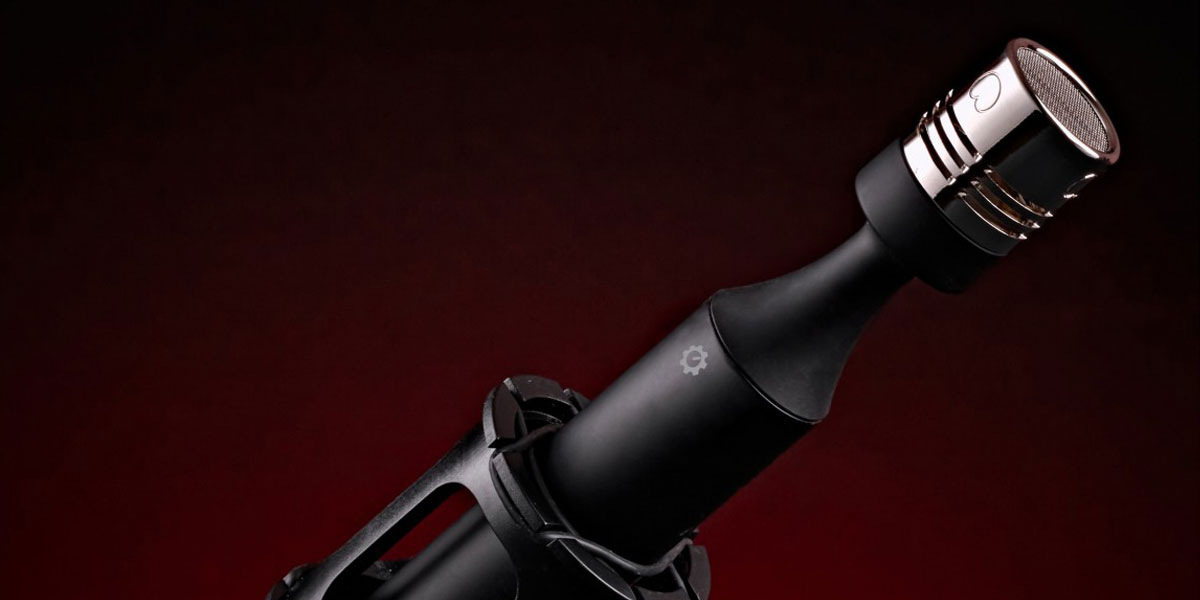
FAQs
Are cheap microphones worth it?
Opting for a cheap microphone can be worth it if it’s of good quality and offers the features you’re after. The performance depends on the specific model, so it’s crucial to check reviews and specs before making a purchase.
How much should a good mic cost?
The cost of a good mic varies greatly, typically ranging from £50 to over £1000. Factors such as brand, type, and features play a big role in determining the price.
Does an expensive mic make you sound better?
An expensive mic doesn’t necessarily make you sound better. The sound quality depends on the microphone’s specifications, not its price. However, pricier mics often come with advanced features that can enhance audio capture.
Final thoughts
Hopefully, our list of the best microphones under £100 has helped you find one that fits your specific needs and shown you that you don’t need to spend a fortune to get good audio capture! If you’re a beginner in the world of mics, we also hope we’ve shed some light on the importance of factors such as price, polar patterns, sound quality, and connectivity.
For information on different types of microphones, don’t miss our informative article. Happy recording!

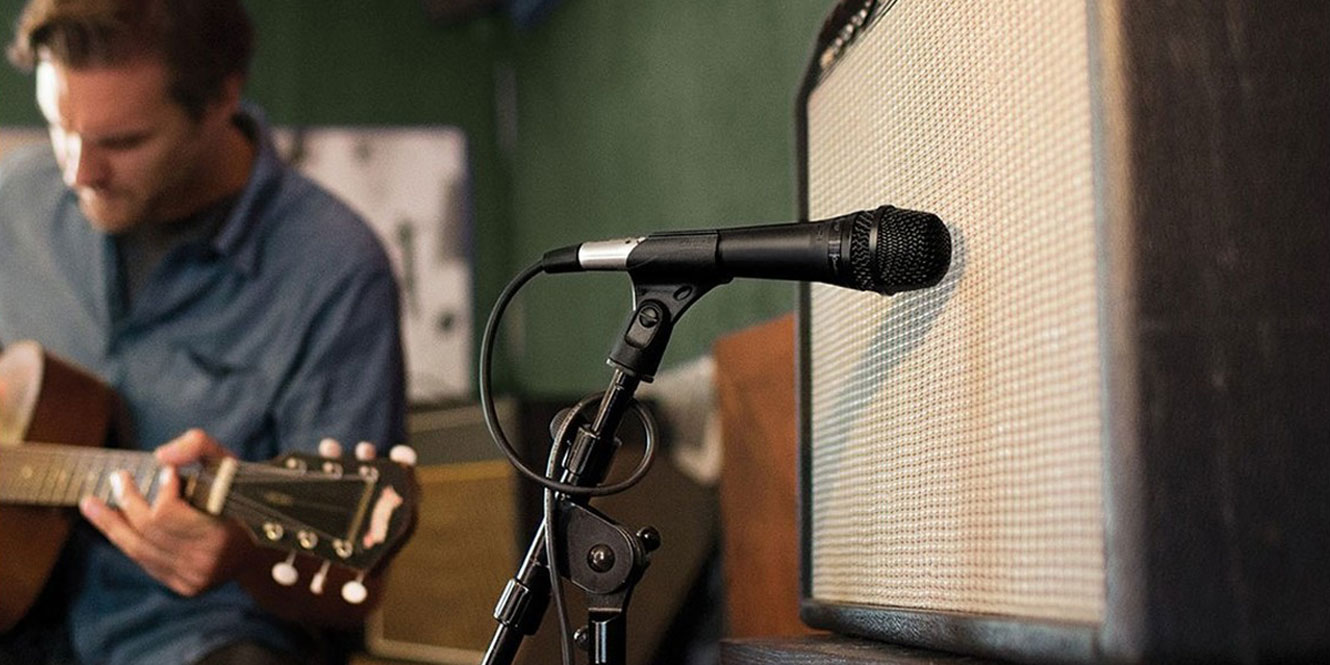











0 Comments